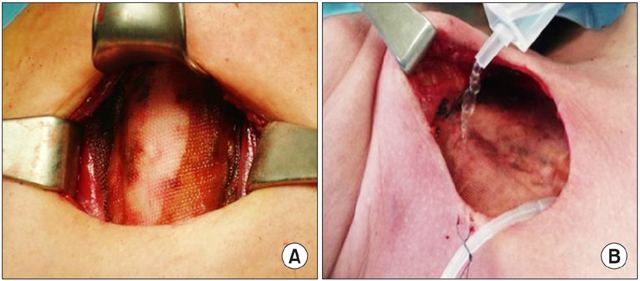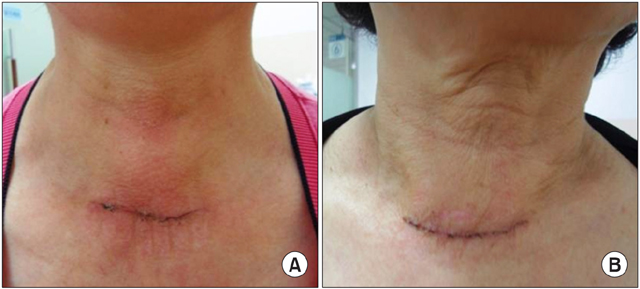J Korean Surg Soc.
2013 Jun;84(6):321-329. 10.4174/jkss.2013.84.6.321.
Antiadhesive effect and safety of oxidized regenerated cellulose after thyroidectomy: a prospective, randomized controlled study
- Affiliations
-
- 1Department of Surgery, Konkuk University School of Medicine, Seoul, Korea.
- 2Division of Endocrine Surgery, Department of Surgery, Seoul National University College of Medicine, Seoul, Korea. ykyoun@plaza.snu.ac.kr
- 3Department of Surgery, Kyung Hee University School of Medicine, Seoul, Korea.
- 4Department of Surgery, Korea University College of Medicine, Seoul, Korea.
- KMID: 1505181
- DOI: http://doi.org/10.4174/jkss.2013.84.6.321
Abstract
- PURPOSE
To evaluate the antiadhesive effects and safety of an oxidized regenerated cellulose (Interceed) after thyroidectomy.
METHODS
Seventy-six thyroidectomized patients were prospectively randomized into two groups with regard to the use of Interceed. We evaluated each group for their adhesive symptoms using four subjective and four objective items at the 2nd week, 3rd and 6th month after thyroidectomy. All patients were examined for vocal cord motility by indirect laryngoscope at each period.
RESULTS
Total adhesion scores at each postoperative follow-up period decreased with time, but were not significantly different in each group. The median score for swallowing discomfort for liquid was significantly lower in the Interceed group than in the control group 2 weeks after surgery. In addition, the severity of skin adhesion to the trachea was reduced in the Interceed group compared with the control group 6 months after surgery. During the study, there were no adverse effects or significant differences in postoperative complications between the groups.
CONCLUSION
Interceed appeared to be safe and effective in improving neck discomfort at early postoperative periods and preventing skin adhesion to the trachea 6 months after thyroidectomy.
MeSH Terms
Figure
Cited by 1 articles
-
Anti-adhesive effect and safety of a thermosensitive adhesion barrier (Mediclore) for thyroid surgery: a double-blinded randomized controlled trial
Jong-hyuk Ahn, Sang Gab Yoon, Jin Wook Yi, Su-jin Kim, Kyu Eun Lee
Ann Surg Treat Res. 2022;102(6):313-322. doi: 10.4174/astr.2022.102.6.313.
Reference
-
1. Sipos JA, Mazzaferri EL. Thyroid cancer epidemiology and prognostic variables. Clin Oncol (R Coll Radiol). 2010. 22:395–404.2. Jung KW, Park S, Kong HJ, Won YJ, Lee JY, Park EC, et al. Cancer statistics in Korea: incidence, mortality, survival, and prevalence in 2008. Cancer Res Treat. 2011. 43:1–11.3. Jemal A, Siegel R, Ward E, Murray T, Xu J, Thun MJ. Cancer statistics, 2007. CA Cancer J Clin. 2007. 57:43–66.4. Won YJ, Sung J, Jung KW, Kong HJ, Park S, Shin HR, et al. Nationwide cancer incidence in Korea, 2003-2005. Cancer Res Treat. 2009. 41:122–131.5. Lombardi CP, D'Alatri L, Marchese MR, Maccora D, Monaco ML, De Crea C, et al. Prospective electromyographic evaluation of functional postthyroidectomy voice and swallowing symptoms. World J Surg. 2012. 36:1354–1360.6. Safioleas M, Stamatakos M, Rompoti N, Mouzopoulos G, Iannescu R, Salichou V, et al. Complications of thyroid surgery. Chirurgia (Bucur). 2006. 101:571–581.7. Scerrino G, Inviati A, Di Giovanni S, Paladino NC, Di Paola V, Lo Re G, et al. Esophageal motility changes after thyroidectomy; possible associations with postoperative voice and swallowing disorders: preliminary results. Otolaryngol Head Neck Surg. 2013. 03. 22. [Epub]. http://dx.doi.org/10.1177/0194599813482299.8. Silva IC, Netto Ide P, Vartanian JG, Kowalski LP, Carrarade Angelis E. Prevalence of upper aerodigestive symptoms in patients who underwent thyroidectomy with and without the use of intraoperative laryngeal nerve monitoring. Thyroid. 2012. 22:814–819.9. Park JH, Jeong JJ, Kang SW, Nam KH, Chang HS, Chung WY, et al. The efficacy and safety of guardix-sg in patients who are undergoing thyroid surgery: a randomized, prospective, double-blinded study. Korean J Endocr Surg. 2009. 9:127–132.10. Park WS, Chung YS, Lee KE, Kim HY, Choe JH, Koh SH, et al. Anti-adhesive effect and safety of sodium hyaluronate and sodium carboxymethyl cellulose solution in thyroid surgery. Asian J Surg. 2010. 33:25–30.11. Yigit O, Uslu Coskun B, Coskun H, Yilmaz B, Alkan S, Cinar U, et al. Efficacy of anti-adhesive barriers in secondary thyroidectomy: an experimental study. Laryngoscope. 2004. 114:1668–1673.12. Yilmaz O, Genc A, Taneli F, Demireli P, Deliaga H, Taneli C. Assessment of the efficacy of absorbable adhesion barriers on dissection in esophagus operations. Int J Pediatr Otorhinolaryngol. 2007. 71:409–414.13. Ahmad G, Duffy JM, Farquhar C, Vail A, Vandekerckhove P, Watson A, et al. Barrier agents for adhesion prevention after gynaecological surgery. Cochrane Database Syst Rev. 2008. (2):CD000475.14. Alpay Z, Saed GM, Diamond MP. Female infertility and free radicals: potential role in adhesions and endometriosis. J Soc Gynecol Investig. 2006. 13:390–398.15. Brehant O, Pessaux P, Regenet N, Tuech JJ, Panaro F, Mantion G, et al. Healing of stoma orifices: multicenter, prospective, randomized study comparing calcium alginate mesh and polyvidone iodine mesh. World J Surg. 2009. 33:1795–1801.16. Darmas B. Use of barrier products in the prevention of adhesion formation following surgery. J Wound Care. 2008. 17:405–408. 41117. Gonzalez-Quintero VH, Cruz-Pachano FE. Preventing adhesions in obstetric and gynecologic surgical procedures. Rev Obstet Gynecol. 2009. 2:38–45.18. Rosato L, Carlevato MT, De Toma G, Avenia N. Recurrent laryngeal nerve damage and phonetic modifications after total thyroidectomy: surgical malpractice only or predictable sequence? World J Surg. 2005. 29:780–784.19. Kamer E, Unalp H, Derici H, Akguner T, Erbil Y, Issever H, et al. Flapless conventional thyroidectomy: a prospective, randomized study. Surg Today. 2010. 40:1018–1022.20. Tae K, Kim KY, Yun BR, Ji YB, Park CW, Kim DS, et al. Functional voice and swallowing outcomes after robotic thyroidectomy by a gasless unilateral axillo-breast approach: comparison with open thyroidectomy. Surg Endosc. 2012. 26:1871–1877.21. Takamura Y, Miyauchi A, Tomoda C, Uruno T, Ito Y, Miya A, et al. Stretching exercises to reduce symptoms of postoperative neck discomfort after thyroid surgery: prospective randomized study. World J Surg. 2005. 29:775–779.22. Magill CK, Tuffaha SH, Yee A, Luciano JP, Hunter DA, Mackinnon SE, et al. The short- and long-term effects of Seprafilm on peripheral nerves: a histological and functional study. J Reconstr Microsurg. 2009. 25:345–354.
- Full Text Links
- Actions
-
Cited
- CITED
-
- Close
- Share
- Similar articles
-
- A randomized controlled trial to compare the efficacy of regenerated and non-regenerated oxidized cellulose gauze for the secondary treatment of local bleeding in patients undergoing hepatic resection
- Antiadhesive effect and safety of sodium hyaluronate-carboxymethyl cellulose membrane in thyroid surgery
- Comparison of the Intraparenchymal Biocompatibility of Oxidized Regenerated Cellulose and Porcine Small Intestine Submucosa in Rat Kidney
- Wound healing effect of regenerated oxidized cellulose versus fibrin sealant patch: An in vivo study
- Comparison of the Wound Healing Effect of Cellulose and Gelatin: An In Vivo Study






